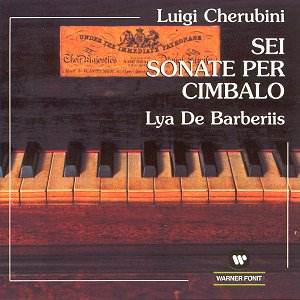 Composer: Luigi Cherubini
Composer: Luigi Cherubini
Works: Sei Sonate per Cimbalo (Six Sonatas for Keyboard)
Performers: Lya De Barberiis (fortepiano)
Recording: Made in Luglio 1977
Label: Warner Fonit 8573 87491-2
Luigi Cherubini, a composer more often associated with dramatic and choral works than with keyboard compositions, offers a fascinating glimpse into his early stylistic development through the Sei Sonate per Cimbalo, composed in 1780 during his studies in Milan. These six sonatas, written for the harpsichord (or “cimbalo” in Italian), reflect the Classical style’s melodic clarity and formal elegance, while also revealing Cherubini’s burgeoning compositional language. Although these sonatas are rarely performed today, they provide a rich context for understanding his later, more significant contributions to music.
Lya De Barberiis’s interpretation on a fortepiano—a choice that might raise eyebrows given the sonatas’ original publication for harpsichord—reveals both the virtues and limitations of this recording. The use of a fortepiano made by W. Dettmer, an instrument from the early 19th century, aligns with performance practices that were nascent at the time of this recording in 1977. De Barberiis executes the virtuosic passages with a commendable dexterity, particularly in the first movements where the melodic lines entwine with complex, toccata-like textures. The first movement of the sixth sonata is particularly noteworthy for its through-composed structure, showcasing Cherubini’s ambition in thematic development, a quality that De Barberiis navigates with considerable flair.
However, the performance exhibits a certain hardness in tone that can be attributed to both the instrument’s limitations and the pianist’s technique. While her articulation demonstrates a solid understanding of the fortepiano’s capabilities, there are moments where a more nuanced touch could have enhanced the expressive potential of Cherubini’s music. The bass, as noted, lacks the richness one might hope for, resulting in a somewhat “thunky” quality that detracts from the overall sonorous experience. The close microphone placement and dry studio acoustics further complicate matters, often rendering the sound less inviting, particularly for listeners accustomed to the lushness of modern grand pianos.
When comparing this recording to other interpretations of the sonatas, it becomes apparent that the historical context of the instruments used greatly influences the listening experience. Modern recordings, while potentially more polished, often miss the raw authenticity that this 1977 effort provides. The conversation around performance practice, particularly with repertoires such as Cherubini’s, remains as relevant today as it was during the early days of the period instrument revival.
The Sei Sonate per Cimbalo stands as a testament to Cherubini’s early compositional voice, its blend of melodic invention and structural experimentation warranting attention despite the challenges presented in this recording. De Barberiis’s performance, while not without its flaws, gives us a glimpse into the interpretative possibilities of Cherubini’s keyboard music. This recording serves not merely as a historical artifact but as a catalyst for discussion about the evolution of performance practices and the enduring relevance of Cherubini’s contributions to the keyboard repertoire. Engaging with this disc invites listeners to reflect upon their own tastes and expectations, making its historical significance all the more profound.



